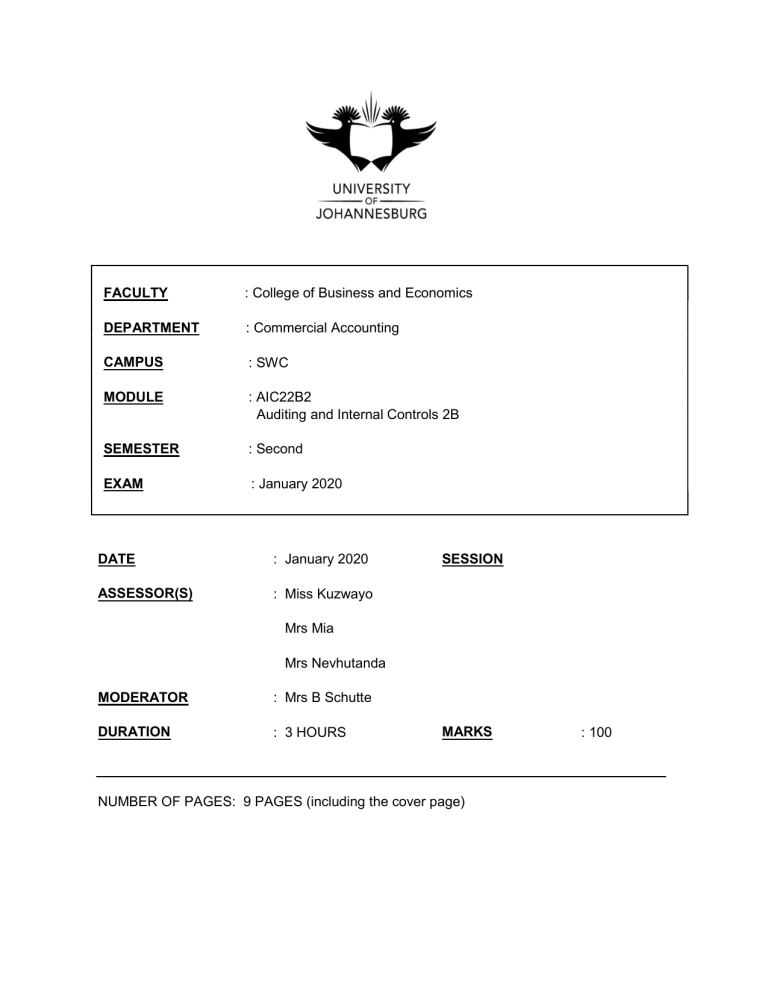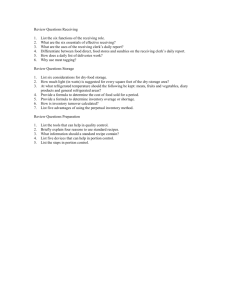
FACULTY : College of Business and Economics DEPARTMENT : Commercial Accounting CAMPUS : SWC MODULE : AIC22B2 Auditing and Internal Controls 2B SEMESTER : Second EXAM : January 2020 DATE : January 2020 ASSESSOR(S) : Miss Kuzwayo SESSION Mrs Mia Mrs Nevhutanda MODERATOR : Mrs B Schutte DURATION : 3 HOURS MARKS NUMBER OF PAGES: 9 PAGES (including the cover page) : 100 FSAO MODULE CODE: AIC22B2 INSTRUCTIONS: 1. 2. 3. 4. 5. 6. 7. You are allowed to use a calculator. An answer sheet/book will be supplied to you, in which you must write your answers in. If you need another book/sheet, please ask the invigilator for another. By writing this test and affixing your name and student number to the answer sheet/book, you confirm that you are conversant with the test regulations of the University. Use only a blue or a black pen to answer your questions. Answers given in pencil will not be marked. Make sure your handwriting is neat and easy to read. Set out your answer in a clear logical manner. Use the same numbers for your answers as those used for the questions in the test/examination paper. Hand your answer book to the invigilator at the end of the test/examination. FSAO MODULE CODE: AIC22B2 QUESTION 1 [BLUE BOOK] [20] Internal control is an important part of any organisation regardless of size, complexity, industry or product line. As a result, internal control is an important part of any auditing course. The topic helps students to start being aware of risks facing business and to think creatively about measures to act against those risks. 1.1. 1.2. 1.3. 1.4. Provide the definition of an internal control. (5) Who is responsible for setting and driving a company’s strategy? (1) Which director is responsible for protecting the information of an entity? (1) Who is responsible for performing risk assessment in the audit process and who is responsible for risk assessment in the internal control process? (2) 1.5. Explain the difference between “monitoring of controls” and “performance reviews”. (2) 1.6. List five items related to human resource practices that an organisation needs to do to create a good Control Environment. (5) 1.7. Identify which component of internal controls is applicable to each scenario below and give a reason for your answer. 1.7.1. iCall is a company that manufactures various gadgets such as cellphones, laptops and tablets. iCall listed on the Johannesburg Securities Exchange (JSE). The board of directors and senior management meet twice a year (every six months) to identify all the challenges facing the entity. They also discuss how each of the challenges can be attended to effectively and appropriately. (2) 1.7.2. iCall has an internal audit function that is appointed by the directors to perform independent assignments on their behalf. The internal audit department, led by Thandeka Mkhize, performs regular reviews of breakdowns in internal controls and how these issues should be fixed. (2) PLEASE TURN OVER THE PAGE FSAO MODULE CODE: AIC22B2 QUESTION 2 [GREEN BOOK] [20] You are a member on the audit team, auditing Gotham University. Management of the university have informed you that during the 2019 financial year, the university entered into a contract with Joker Limited for advertising services in an effort to market the university to students that were completing matric. Part A A junior on the audit team presented the following points to you when you questioned them about their understanding of the cycle: A. The purchase requisition is a document that is sent by Gotham University to Joker Limited to place the order for the advertising services. B. The purchases clerk is responsible for recording the purchase transaction in the purchase journal. C. When the services are provided to Gotham University, the goods received clerk will issue a goods received note to Joker Limited. D. A reconciliation of various documentation including invoices and supplier statements must be done before a payment requisition is prepared. E. As soon as the purchase requisition has been approved by a senior staff member at Gotham University, the accounting department can record the payment in the financial records of the company. REQUIRED: 2.1. For each of the statements described above, state whether they are True or False and provide a reason for each answer. (10) [PLEASE TURN THE PAGE FOR PART B] FSAO MODULE CODE: AIC22B2 Part B As part of conducting the audit, you realised that the purchase of the service was recorded by Gotham University as follows: Dr Advertising Service Expense R 15 000 Cr Trade Receivables R 15 000 Note: Universities and other tertiary institutions in South Africa are VAT exempt and therefore do not need to account for VAT. REQUIRED: 2.2. What are some of the general risks relating to the payment part of a cycle in a business? (2) 2.3. Explain whether the journal entry processed by Gotham University is correct or not. (2) 2.4. List the assertions relating to the Statement of Financial Position of Gotham University (as at 30 June 2019) that will be affected by the journal entry and explain how these assertions will be affected. (6) Present your answer in a table like the one included below: Assertion Account affected & reason PLEASE TURN OVER THE PAGE FSAO MODULE CODE: AIC22B2 QUESTION 3 [ORANGE BOOK] [20] The audit team presented the following report on a year-end inventory count of Clean-books (Pty) Ltd. The year-end for Cleanbooks (Pty) Ltd is July 2019. The inventory count took place over two afternoons, from 1pm to 5pm on 30 and 31 July. This was to enable the company to receive and dispatch goods during the morning. The count was carried out by the six warehouse employees who usually pick the goods to fill orders. This worked well because they are familiar with the nature of the inventory and they know where everything is stored. The pickers decided amongst themselves which section of the warehouse to count. Maggie Motolo, the warehouse administration clerk, printed a list off the computerised perpetual inventory system (inventory sheet) of each item (description and quantity) in the section chosen by the picker. The numerically sequenced inventory sheets were handed to the pickers who then counted each item in their section of the warehouse, ticking off the quantities on the inventory sheets once they had counted the item. If the count quantity differed from the quantity on the inventory sheet, the counter (picker) highlighted the item and quantity and wrote in the number he had counted. At the conclusion of the count on the second day, the counters returned the inventory sheets to Maggie Motolo who identified the highlighted items and amended the quantities on the perpetual inventory records to reflect the actual quantities on hand. Prior to the count, the auditor (Thomas Chauke) confirmed with the financial accountant that they would be attending the inventory count. The audit team did the following: - accompanied each picker for a short period of time on each day to observe them counting. - allocated the six sections between the audit team, compiled a count workpaper by selecting inventory items (on a random basis) from the counters’ inventory sheets, and performed a physical count of the items selected. entered the count quantity for each item counted on our workpaper (which is attached). - observed Maggie Motolo adjust the quantities on the perpetual inventory records. Thomas initialed each of the inventory sheets and left them in the custody of Maggie Motolo. REQUIRED Discuss the weaknesses in the year-end inventory count, based on the information given above. (20) PLEASE TURN OVER THE PAGE FSAO MODULE CODE: AIC22B2 QUESTION 4 [YELLOW BOOK] [20] Part A During your Auditing lectures, you were taught various aspects of the revenue and receipts cycle such at the characterists, functions, personnel involved in the cycle, what can go wrong as well as the assertions that are applicable. REQUIRED: 4.1 4.2 What does the Revenue and Receipts cycle deal with? List three (3) functions that exist in the Revenue and Receipts cycle and explain the purpose of each function listed. (2) (6) Part B Swoosh (Pty) Ltd is a company that sells popular sports clothing and sneakers. Their slogan is “Just Did It.” The company is a VAT vendor. Swoosh sells its items online and has one store at Liaparo Mall in Soweto. This store is open to the public and all products bought online are taken from the store in Liaparo Mall to fulfil the online orders. Customers can buy Swoosh products on credit either online or in the store. Customers can apply for an account to buy on credit online. Customers are required to complete the application form and do not need to submit any supporting documentation if they tick the following item of the application form: I declare that the information provided in the application form by me, the applicant, is correct. I also declare that I have disclosed all relevant and important information in the application form. Once the credit application is approved and an order is placed online, the sales clerk manually calculates the VAT amount in order to determine the selling price of the products ordered. The sales clerk then proceeds to send the internal sales order form to the accounts department to record the sale. The inventory management system that the company uses, only updates stock levels at 05:00 each morning. REQUIRED: IMPORTANT: Please answer Part B in a table format as shown below 4.3 a. Discuss what can go wrong in the scenario above with respect to the revenue and receipts cycle. (3) b. You are required to give a reason for your answer. (3) FSAO MODULE CODE: AIC22B2 c. Identify the assertions that are affected as a result of each risk identified with respect to revenue and debtors. (3) d. You are required to give a reason for each assertion identified. (3) TIP: Most of the marks will be allocated to reasons for justifying what can go wrong. 4.3a Risk identified 4.3b Reason for risk 4.3c 4.3d Assertion Reason for assertion 1 2 PLEASE TURN OVER THE PAGE FSAO MODULE CODE: AIC22B2 QUESTION 5 [PURPLE BOOK] [20] The payroll cycle deals with the payment of salaries and wages to employees as well as related expenses to third parties on behalf of its employees. This cycle has numerous risks that may lead to the material misstatement of an entity’s financial statements. REQUIRED: 5.1 5.2 5.3 5.4 List the 4 (four) characteristics that wage employees have. (4) List and define the assertions that are applicable to the payroll taxes liability. (10) Bonus (Pty) Ltd has a gross (total) salary expense of R 680,000 for April 2019 of which R590,000 is directly paid to employees on 25 April 2019 and the balance is payable to the South African Revenue Services (SARS) on 7 May 2019 with respect to payroll taxes (PAYE). Provide the accounting journal entry/entries (including narrations) that should be processed on 25 April 2019 in the books of Bonus (Pty) Ltd. (4) Identify 2 (two) functions in the payroll cycle of a large manufacturing company. (2) THE END



